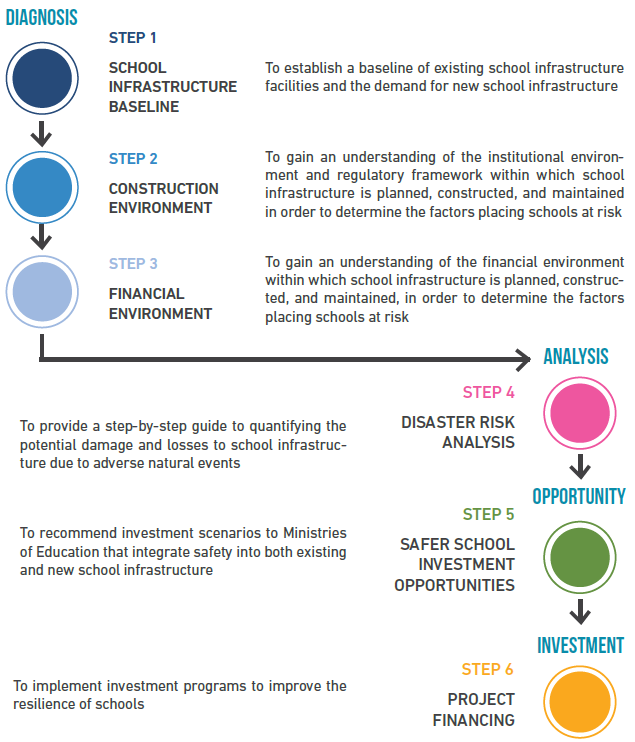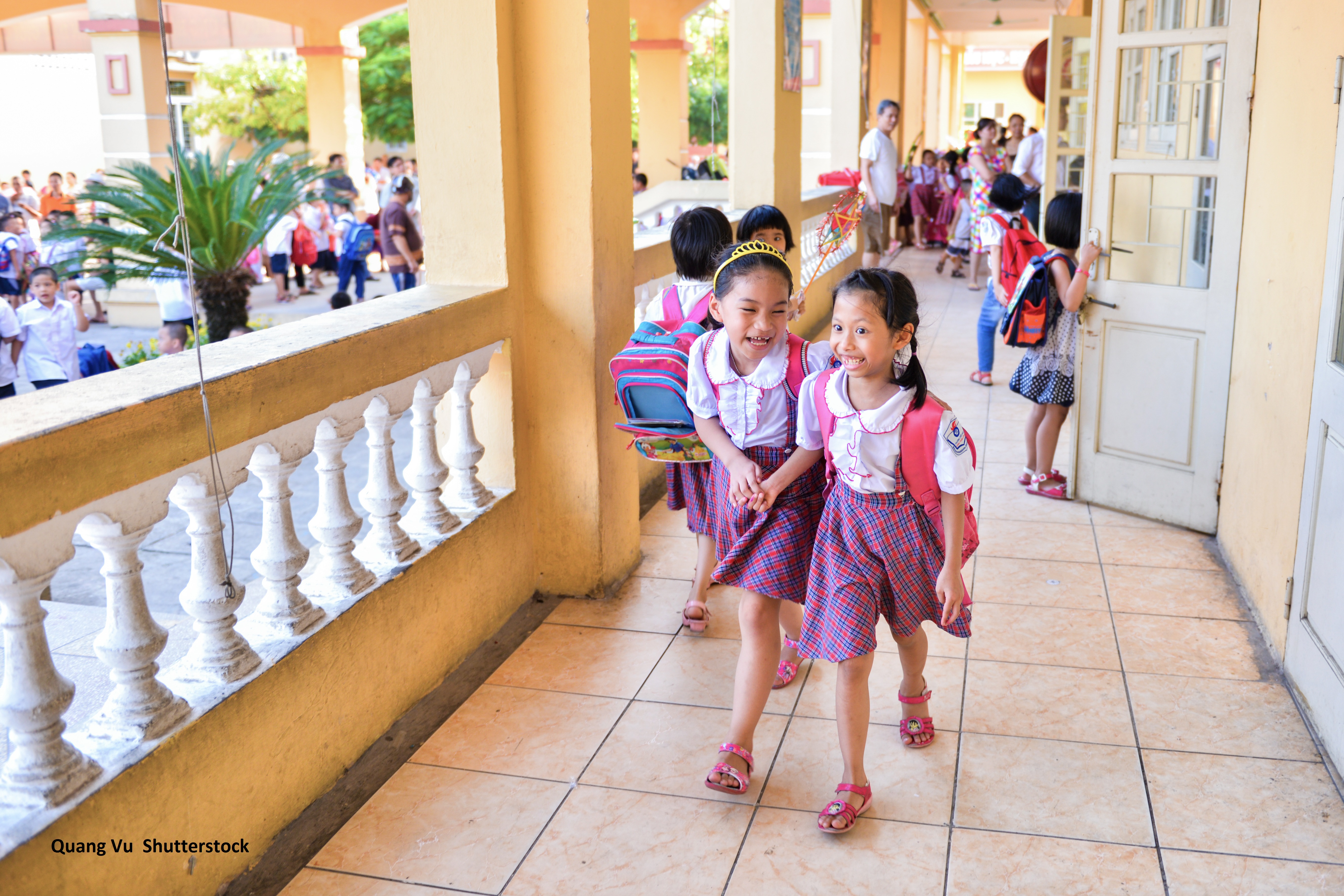Click to view: Context | Strategy | Partners | Results | Related | Videos
Context
Each year, They cause direct harm to children, teachers, and the school community, damaging or destroying school infrastructure.
Although there is no consolidated study on the impacts of natural hazards on the education sector worldwide, partial data are instructive. For example:
- In Bangladesh, Cyclone Sidr in 2007 damaged almost 6,000 schools and disrupted the education of more than 1.5 million students.
- In the Philippines, Typhoons Ondoy and Pepeng in 2009 affected over 1 million schoolchildren and damaged a total of 3,417 schools. A typhoon in 2013 damaged over 2,500 schools.
- In Ecuador, the 2016 earthquake damaged almost 1,000 schools and left over 120,000 children temporarily without education.
- In Haiti, Hurricane Matthew in October 2016 damaged over 730 schools.
- In Mexico, on September 19, 2017 a 7.1-magnitude earthquake affected a total of 13,000 schools, including 577 schools damaged beyond repair and the collapse of a primary school that killed 19 pupils and seven adults.
In addition to their immediate direct impacts, in the medium term, particularly as recovery and reconstruction go forward.
Damaged school infrastructure exposes the educational community to physical and mental stress and interferes with school operations, teaching, and learning. When non-resilient communities experience a natural disaster, the effort to bring children back to school and recover the full operation of the education sector is prolonged, often involving a lengthy emergency response and a protracted recovery and reconstruction process.
In Nepal, for example, the 2015 earthquake left children across the country without access to education for three weeks. Similarly, it may take the Philippine education sector over four years to recover from the 2013 typhoon Haiyan.
Global Program for Safer Schools
The Global Program for Safer Schools (GPSS) aims to boost and facilitate informed, large-scale investments for the safety and resilience of new and existing school infrastructure at risk from natural hazards, contributing to high-quality learning environments. The focus is primarily on public school infrastructure in developing countries.
Funded by the Global Facility for Disaster Reduction and Recovery (GFDRR), the GPSS was launched in 2014, building on the experience and lessons learned from the World Bank’s safe school projects in countries such as Colombia, Philippines, and Turkey. As a World Bank program, GPSS seeks to:
- Build evidence-based knowledge and tools for informing investments at scale and long-term engagement on safer schools;
- Play an important role in promoting and facilitating the integration of risk reduction criteria into World Bank-funded education infrastructure projects; and
- Integrate safety improvements into comprehensive solutions for quality learning environment for children in developing countries.
Strategy
The Comprehensive School Safety (CSS) framework is the most recent global agreement seeking to reduce disaster risk in the education sector. The CSS rests on three pillars:
- Safe learning facilities, focusing on risk reduction of school infrastructure;
- School disaster management, focusing on emergency preparedness and educational continuity plan; and,
- Risk reduction and resilience education, focusing on developing the culture of safety and resilient communities.
While the United Nations, NGOs, and other development partners have focused on Pillars 2 and 3, the GPSS focuses on Pillar 1—safe learning facilities.
The GPSS’ approach lies in these main arguments:
Impact: The accumulative impact of disasters exacerbates the learning crisis, and makes it harder for governments to finance and operate a growing stock of school facilities and ensure the continuity of educational services, especially in the poorest areas.
Progress so far: Despite international agreements to reduce disaster risk and address climate change, there have been few policy changes or investments to promote the safety of school infrastructure. In developing countries, in particular, progress to reduce the vulnerability of new and existing school infrastructure has been very limited.
Moving forward: Policy changes and decisions within a country that lead to large-scale investments in the safety of school infrastructure are likely to happen, if at least four conditions are in place:
- The dialogue between decision-makers and stakeholders is strengthened with evidence-based arguments throughout the process (planning, design, construction, operation, maintenance, and rehabilitation of schools);
- Financial incentives linked with progress on risk reduction are created to encourage action by central and local governments;
- Affordable technical solutions are available and can be customized to the local context; and
- Knowledge base is available to provide access to information.
The GPSS operates at both global and country levels in support of developing countries.
At the global level, the program focuses on generating evidence-based knowledge and making it available worldwide to promote and facilitate a long-term and systematic approach to improving the safety of school infrastructure at scale, using quantitative risk assessments.
At the country level, the program supports—through World Bank projects—governments’ efforts to: design and implementation of safer school programs; influence policy reforms and wider investments in risk reduction that create safer school environments; and inform long-term national strategies that prioritize safety at scale and link previous and ongoing activities in the education sector.
The program is structured through pillars, components, and activities as follows:
Pillar 1: Develop global evidence-based knowledge on safety and resilience of school infrastructure.
1.1. Impacts of disaster risk on the education sector.
1.2. Solutions and innovation for safe and resilient school infrastructure networks.
1.3. Tools to inform investments for vulnerability reduction of school infrastructure networks.
Pillar 2: Integrate risk reduction considerations into World Bank education infrastructure operations.
2.1. Screening of school infrastructure investments in World Bank education operations.
2.2. Guidance notes and tools for task teams to integrate risk into World Bank operations.
2.3. Learning by doing: Technical assistance to selected ongoing World Bank operations.
Pillar 3: Provide technical advice for in-country activities and facilitate the design of risk-informed investments.
3.1. Diagnosis of school safety at country level.
3.2. Grant resources for in-country activities.
Pillar 4: Make available knowledge products.
4.1. Web-based platform and IT solutions.
4.2. Accelerated solutions through e-learning.
The Roadmap for Safer Schools
To promote a systematic approach, a guidance note titled “Roadmap for Safer Schools” was developed in 2016 and launched in January 2017. The roadmap is an operational tool to guide the interactions of World Bank project leads with infrastructure managers and stakeholders, to promote a more informed and structured dialogue on investing in the safety of new and existing school infrastructure as a means of mitigating disaster risk.
The roadmap consists of six steps that follow a logical sequence from diagnosis to analysis, opportunity, and investment. The guidance note focuses on Steps 1–5; Step 6 is the dialogue with the government about World Bank support.

The roadmap itself uses concepts and language that are accessible for those without experience in disaster risk reduction and construction, and it provides guidance on the technical expertise required by the activities.
Another guidance note, “Roadmap for Reconstruction and Recovery,” is being prepared as a guide to help World Bank project leads and infrastructure managers navigate the recovery and reconstruction process for school infrastructure within the post-disaster context. The purpose of this roadmap is to offer governments timely support in their recovery and reconstruction efforts and to improve the safety and resilience of educational infrastructure in affected areas following a disaster.
Results
The program has initiated activities in 12 countries across five regions with a total of $8.5 million in grants. In addition, the program has provided technical support to World Bank project teams through a number of diagnostic field visits—in Afghanistan, Armenia, Indonesia, Mongolia, and Pacific Island countries (Samoa, Tonga, and Vanuatu)—which aim to understand the available school infrastructure baseline data as well as the local construction and financing environments. Such visits help to identify potential opportunities where GPSS technical assistance could support clients in the design of risk reduction strategies and investments in safer education facilities.
GPSS In-Country Technical Assistance Activities
Region | Country | Grant amount (USD) |
ECA | Armenia | 500,000 |
LAC | El Salvador | 1,000,000 |
EAP | Indonesia | 700,000 |
LAC | Jamaica | 600,000 |
ECA | Kyrgyz Republic | 500,000 |
AFR | Mozambique | 1,150,000 |
SAR | Nepal | 1,500,000 |
EAP | Pacific (Samoa, Tonga, Vanuatu) | 700,000 |
LAC | Peru | 1,400,000 |
ECA | Turkey | 500,000 |
Total | 8,550,000 |
Note: ECA = Europe and Central Asia ; LAC = Latin America and the Caribbean; EAP = East Asia and Pacific; AFR = Africa; SAR = South Asia.
Partners
The Global Program for Safer Schools is building partnership with academia, the private sector, and development partners to advance the safer school agenda. The program has partnered with University College London, University of Los Andes from Colombia, and the Swiss Federal Institute of Technology in Switzerland to establish a working group to develop the Global Library of School Infrastructure. The GPSS is also developing in-country partnerships with stakeholders working on the ground, including United Nations agencies such as UNICEF, and development partners such as the Asian Development Bank (ADB) and the Japan International Cooperation Agency (JICA).
Related
- Roadmap for Safer Schools
- Blog series on Global Program for Safer Schools
- Making Schools Resilient at Scale: the Case of Japan
- Towards Safer School Construction - A community-based approach
- Making Schools Safer to Disaster in Peru: Japan Delegation Visit
- Mozambique Initiative Aims to Build Safer Schools, Protect Children from Disasters
- World Bank Administers School Construction Projects under the Facility for Refugees in Turkey
- Prevention and Preparedness: An Integrated Approach to Disaster Risk Management in Turkey
- The Istanbul Seismic Risk Mitigation Project
- Nota Técnica: Estrategia de Reducción del Riesgo Sísmico de Edificaciones Escolares Publicas del Perú
- Informe Técnico: Estrategia de Reducción del Riesgo Sísmico de Edificaciones Escolares Publicas del Perú
- Nota Técnica: Propuesta de Plan Nacional de Infraestructura Educativa en Perú al 2025: Metodología de costeo de las intervenciones
- Technical Note: Identification of investment needs in school water and sanitation infrastructure in Peru (English) (Spanish)
- Technical Note: Evaluation of the water and sanitation system in schools: Comprehensive water and sanitation system (SIASE) (English) (Spanish)
Videos
- Launch of the Roadmap for Safer Schools
- Reducing Seismic Vulnerability in Peru (English) (Spanish)
- Supporting Reconstruction efforts in Nepal
